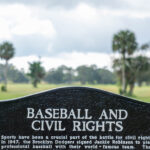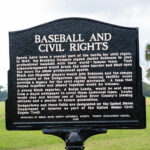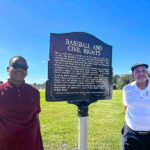
Once it was the only place on the Treasure Coast where Black and white golfers could tee off together during segregation. But for the last 20 years or so, the 35-acre parcel at the southeast corner of Aviation Boulevard and 43rd Avenue sat fallow, gathering weeds and growing unsightly over time.
The parcel with a storied past now has a bright future. Indian River County, which bought the parcel from the City of Vero Beach for $2.45 million in 2019, plans to develop it as a public park. The property, once eyeballed by residential and commercial developers, has been cleared and a nature trail now meanders through it.
While specific plans for the park are still in the “what if?” stage, county staff have a vision of what could be there, said Michael Zito, the county’s Deputy Administrator.
“We have to work with the city and because it’s in the flight pattern for the airport, the Federal Aviation Administration has to approve anything we do there,” Zito said. “Once we get a feel for what is permittable there, then we can present commissioners with some concepts and begin a master plan for the park.”
Zito says he foresees “a lot of greenspace,” similar to Joe Wiggins Field, a multi-use sports field at the county’s Intergenerational Center on Oslo Road. The county plans to solicit input from residents about what they would like to see there.
Meanwhile, historians commemorated the property’s importance to the nation’s civil rights movement by erecting a Florida Historical Marker on the site on Saturday, Nov. 8. Dodgertown and the former golf course have been officially recognized by the U.S. Department of the Interior as part of the United States Civil Rights Trail.
That part of the story begins in 1948, when Branch Rickey, president of the Brooklyn Dodgers, chose a former Naval Air Station in Vero Beach as the site for his team’s spring training camp. And as nearly everyone, baseball fan or not, knows, Rickey made history the year before by signing a talented 28-year-old ballplayer named Jackie Robinson as his new first baseman – the first Black player signed to the Major Leagues.
The shockwave that jolted through the sports world reached all the way to Vero Beach the next spring when Robinson came to train at Dodgertown in Vero Beach, the league’s first integrated spring training camp.
Dr. A. Ronald Hudson, a retired long-time educator in Indian River County, remembers Robinson’s first spring training game in Vero Beach on March 31, 1948.
“We had heard so much about Jackie Robinson,” Hudson recalls. “I was 14 years old. We got permission to leave school early. We had saved up our pennies for the 50 cents needed to get into the game. Bus fare was another 10 cents, but we didn’t have enough money, so a group of us walked along the railroad tracks to the field.”
The original field was where Piper Aircraft’s parking lot is today. Hudson and his friends joined about 5,000 others who had come, many from great distances, to see Robinson play, he said. “I had never seen that many people in one place before,” he said. Black folks were segregated on one side of the field, with white people on the other side.
In his first at-bat Robinson hit a homerun. Black fans cheered, while the white fans booed and yelled racial slurs, Hudson said. “It was just terrible. But for us, it was exciting just to know that a Black man had been accepted on a major league baseball team — and here he was, right here in our back yard.”
The Dodgers then-president Walter O’Malley built the 6,500-seat Holman Stadium in 1953. Robinson and the Dodgers went on to win the World Series in 1955. Over time, additional Black players joined the team. Robinson retired from the Dodgers in 1957.
By the 1960s, local schools were still segregated. There were two golf courses in Vero Beach at the time. Neither one allowed Black players.
So a few men in Gifford, led by Sam Miller, decided to build a three-hole course for themselves in a field between the elementary school and the high school, said John Thornton. “There was a group of us who played every day,” Thornton recalls. “I mostly caddied for the other players. But it shows that sports was very important to the success of youngsters in Gifford.”
The group called themselves the Par Five Golf Club.
In 1965, Black Dodger players included outfielders Willie Crawford, Tommy Davis, Willie Davis and Lou Johnson, third baseman Jim Gilliam, shortstop Maury Wills, and catcher John Roseboro. O’Malley bought the parcel at Aviation and 43rd and constructed a nine-hole golf course so all his players could enjoy the game together.
O’Malley invited the Gifford golfers to play on the course when spring training was not in session. “It was a great time,” said Thornton. “That was the only course I played on for years.”
Eventually the club grew to include players from St. Lucie County, so the men changed the name to the Par Five Club of the Treasure Coast, Thornton said. The club still exists and participates in the Sunshine State Golfers Association, a group of 10 clubs across the state with all-Black members.
“Indian River County, Vero Beach and Dodgertown played a big role in opening up baseball for Black players, but also in creating a smooth transition when local schools were integrated in 1968,” said Ruth Stanbridge, president emeritus of the Indian River Historical Society. “The players all got along because they were housed together, ate together, worked together and played together.”
And that is the reason for the historical marker, Stanbridge said. “That property has a history, it has a present, and now it definitely has a future. It belongs to the public. That’s what it’s all about.”
- PHOTO BY JOSHUA KODIS
- PHOTO BY JOSHUA KODIS
- PHOTO BY JOSHUA KODIS
- PHOTO BY NICK SAMUEL
- PHOTO BY NICK SAMUEL








